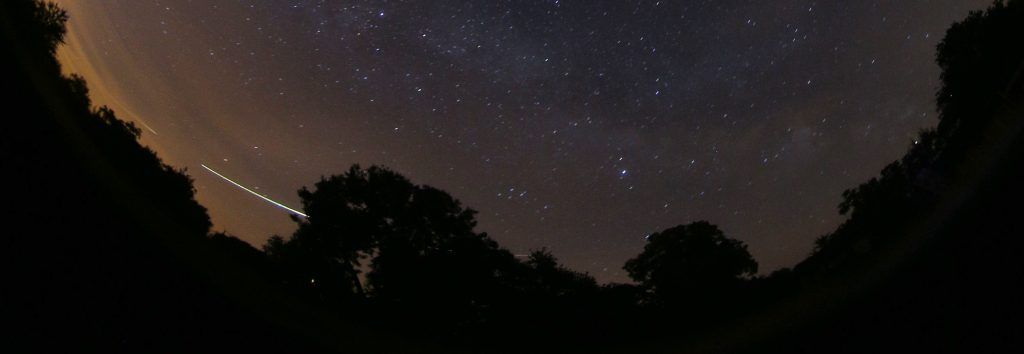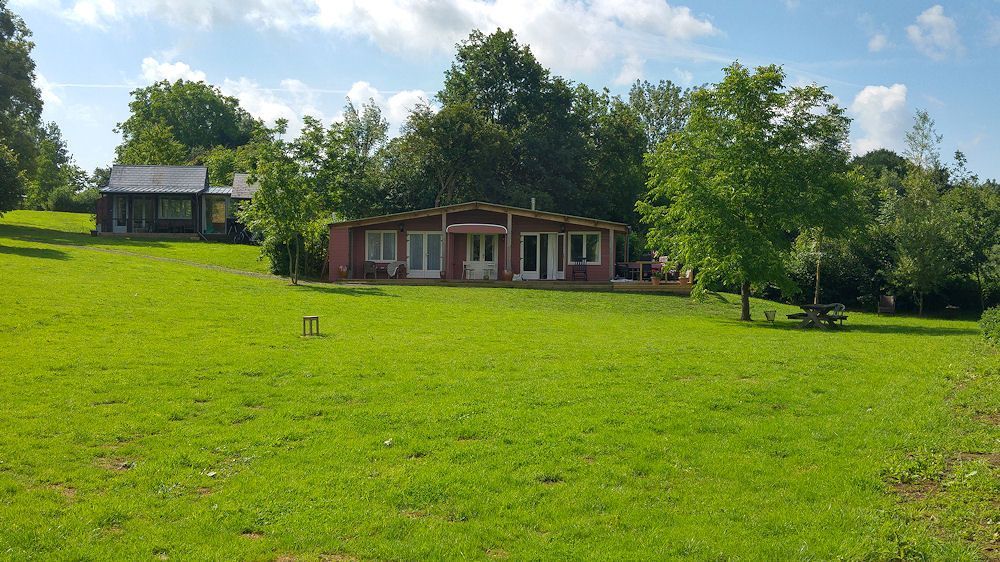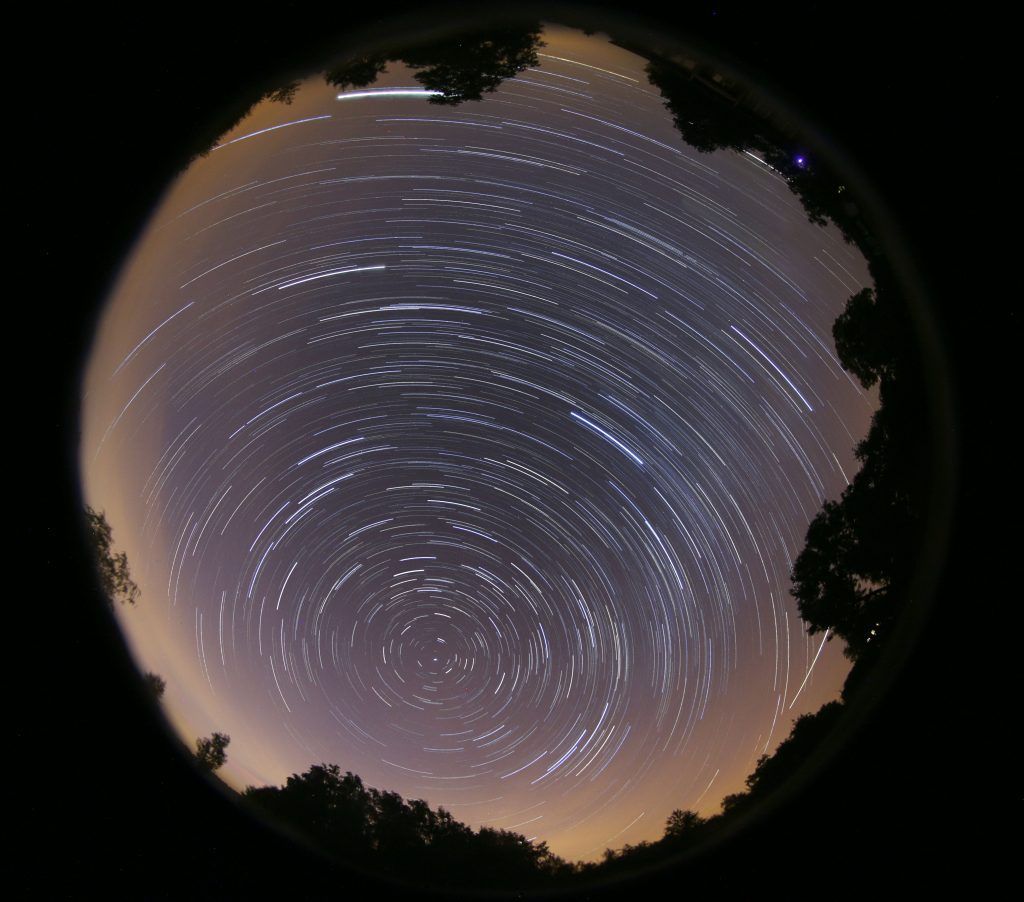
Figure 1. Crop of all sky image of the fireball of June 13, 2018.
Introduction
In the period from June 2 to 16 2018 I rented a house from Bel Any. This is a small resort in Any Martin Rieux, a tiny French village near the Belgian border. I already stayed here during the Orionids 2017 [1]. In spite of the bad weather, we enjoyed it so much that we planned a longer vacation now. An additional advantage for the author was that the village is located in a dark area. Observing was not a must in itself, because meteor activity is always low in June. Still, I was curious about the night conditions in June, compared to October 2017 and with the circumstances in Ermelo in June (the so called gray nights).
In October 2017 I reached a limiting magnitude of 6.7, I easily saw the Gegenschein and a SQM of 21.22 with the exception of the fact that in my opinion the circumstances were not optimal.
Unfortunately, the weather this year was again a problem. Not during the day, we had very good weather with little rain and nice temperatures. The night-time observing activities did suffer from the fact that there were frequent remnants (cirrus) of thunderstorms. Eventually I could observe visually during three nights. The all sky camera was used on 7 nights. A report.

Figure 2. Our rented gite on the large property of Bel Any. The stool served as a tripod for the all sky camera.
2/3 June 2018
Because of the 50% moon I could not observe the whole period this night. The all sky camera started at 21:00 UT. In the Netherlands I can start visually around 22:30 UT at the beginning of June. This is much earlier at Any Martin Rieux, I could start at 21:40 UT. The Lm was already 6.0 and the SQM reached 20.25. This quickly increased to Lm 6.4 and SQM 21.20 around 22:30 UT, but then steadily declined due to the rising moon. The session ended at 23:15 UT. In the meantime it had become somewhat foggy in the meadow next to me . The starry sky was beautiful with Jupiter in the south, to the left the constellation Scorpion, which is noticeably higher in the sky here than in the Netherlands. The Milky Way popped out, looked flabby and was clearly visible far below Scutum. Man, this is so enjoying….
In total I counted 15 meteors during this period, all weak ones. The brightest meteor was a +2 SPO. Attention was paid to ANT and possible activity of the tau Herculids. The problem with the latter is that different radiant positions can be active. I chose not to learn this from my head but to properly describe the very slow meteors radiating from a large area including Hercules and Boötes. A striking moment was that within a few minutes I observed two very slow (20 km / s) meteors radiating from an area just to the right of the triplet eta, tau and upsilon Boötes (RA 202, Dec +18), respectively magnitude +4 and +5 . I do not know whether these were tau Hercules, they were the only very slow meteors that night.
Around 22:36 UT a double satellite formation became visible in the south. Both satellites were magn. -3 but soon extinguished to +4. I could follow them for a long time thanks to the clear sky. And in the evening twilight I saw two ISS passages.

Table 1. Meteor counts June 2/3 2018
https://www.imo.net/members/imo_vmdb/view?session_id=76607
3/4 June 2018
In the evening the sky above Any Martin Rieux is full of thin cirrus clouds. Despite the cirrus, I took a short nap to get some rest before the observations started. When I started a large part of the cirrus was dissolved, only low in the southwest, west and north there was still a lot of cirrus, but the viewing direction was south-south-east. This situation remained so throughout the session. I also wanted to observe a half hour longer than yesterday’s session, but unfortunately due to a nasty hay fever attack I was forced to stop earlier.
I could observe between 21:40 and 23:15 UT. It resulted in t.eff. 1.47 hours, lm 6.4 and a maximum SQM of 21.28! This is more than in October 2017 despite the gray nights! Again it shows how beautiful dark it is there. In total I counted 14 meteors, of which 3 were ANT meteors. No slow meteors from Hercules or Boötes. Best meteor was a white sporadic magnitude +1 with a short persistent train in the southern part of Ophiuchus.

Table 2. Meteor counts June 3/4 2018
https://www.imo.net/members/imo_vmdb/view?session_id=76608
13/14 June 2018
At first I had little hope for a good result. There was cirrus everywhere in the sky, but thanks to the darkness I did not have that much trouble with it. Eventually the amount of cirrus became less and it became completely clear. I was able to observe between 21:49 and 00:51 UT, which effectively yielded 3.00 hours of observation time. The lm rose again to 6.4, the SQM went even higher than in the previous nights: 21.31 maximum. Thanks to the dark conditions I got more meteors now, a total of 41 meteors were counted, of which 7 radiated from the Antihelion region.
This night I witnessed a very beautiful fireball. At 22:50 UT I noticed a slow meteor of magn. +2 near the star theta Aquila, which moved to the northeast and then disappearing behind a tree when the meteor was brightening to magnitude -2. It flashed through my head: “I hope she goes on long enough that she becomes visible again!”. Through the tree I saw the thing moving and indeed it became visible again as a bright yellow meteor of -3 with a few short flares up to -4. The wake also became long, about 1 degree. After the two short flares, a lot of fragmentation was visible in the form of sparks that “fly along”. I estimated that a maximum of 7 or 8 pieces were moving along with the meteor, which became weaker. Eventually the fireball went out as three red meteors of magnitude +2 near the star gamma Andromeda. WOW and again wow! I estimate that the entire meteor has lasted 8 seconds with this extremely long path! Later on I noticed the fireball was captured by many all sky stations in Germany, Belgium and the Netherlands.
Furthermore, many weak meteors were seen this night. But around 23:28 UT (~ a few minutes) a beautiful earthgrazer was seen, moving from Cepheus to Arcturus (alpha Boötes), magn. +2 with an afterglowing track. The meteor resembled a lot like the ETAs of early May.

Figure 3. Startrails image of the fireball of 13 June 2018 22:50 UT.
From 00:45 UT, thicker cirrus began to appear from the west again. Too bad, because I wanted to continue until dusk to see a possible Ariëtid. At 00:51 UT I had to stop without seeing anything of this meteor shower. But I was satisfied, this was a nice session.

Table 3. Meteor counts June 13/14 2018
https://www.imo.net/members/imo_vmdb/view?session_id=76609
It also turned out to be the last clear night at Any Martin Rieux. On the evening of the 15th I made another attempt, but just before I wanted to start, lower clouds appeared in the south suddenly, marking black against the starry skies and slowly moving northward.
On Saturday the 16th we returned home to Ermelo.
.

